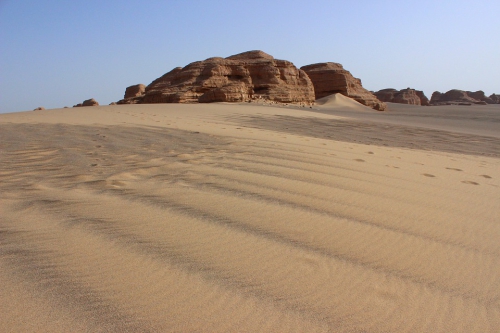Human Activities Have Worsened Air Quality in Dunhuang, a Desert Basin in Western China
Date:2017-06-30
Dunhuang is a typical desert basin, with the Qilian mountains to the south, Kumtag desert and Lop-Nur to the west, Beisai mountain to the north, and Sanwei mountain to the east. Besides, the famous Taklimakan and Tengger deserts are also located in the west and east of Dunhuang region, respectively. Dunhuang is also a world-famous scenic spot, encompassing Mogao Caves, Crescent Spring and Mingsha Mountain within its territory.
Through analyzing aerosol observational data for the year 2012 and comparing them with previous aerosol observations in 1999 and 2004–07, a recent study by Institute of Atmospheric Physics/Chinese Academy of Sciences concludes that, due to the increasing contribution of human activities, air quality has become worse in the most recent decade over the Dunhuang area, and the main reason is a shift to a mixture of coarse and fine particles, having previously been due to dust aerosol alone.

Dunhuang lies in western China and was a major stop on the ancient Silk Road. According to the statistics of Dunhuang Tourism Bureau,67 400 tourists visited Dunhuang during May Day Holiday in 2017, 17.22% more than last year. (Image by Pixabay)
The study also reveals significant seasonal characteristics for aerosol optical properties. The maximum aerosol optical depth (AOD) was found to occur in spring, while the remaining three seasons were similar. Frequent dust weather events made dust aerosols the dominant component during spring. The peak tourism season occurs in summer and fall and, due to the relatively more intense level of human activities during this period, fine urban aerosols were found to be the main mode of control in summer. In fall, the dust influences combined, and urban-dust aerosols occupied the maximum proportion. Numerous fine black carbon and sulfate aerosols were emitted by coal combustion in winter, mixed with relatively frequent dust aerosols, resulting in a mixed mode taking the principal control during this season.
Finally, this work, published in Advances in Atmospheric Sciences, found Dunhuang to be seriously affected by dust aerosols transported by high-frequency northwest air masses in spring, fall and winter, leading to the highest AOD values. Urban aerosols accounted for a considerable proportion in northwest (summer) and west (fall) air masses. Regional coal combustion produced a large amount of fine pollution aerosols during winter, and the different air masses exhibited similar diffusion behavior for the regional pollutants.
Reference
Ma, Y. J., and Coauthors, 2017: Optical properties and source analysis of aerosols over a desert area in Dunhuang, Northwest China. Adv. Atmos. Sci., 34(8), doi: 10.1007/s00376-016-6224-6,
Contact: MA Yongjing, mayongjing@dq.cern.ac.cn
